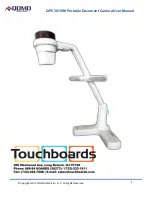
(in feet) to which the lens is to be set on the helical focusing scale. The corresponding figure above then gives the
distance of the near limit (in feet and inches) and the figures below give the far limit (in feet and inches) of the
depth of field.
For easy application of the tables with those cameras which have been made for the continental market and
consequently have been calibrated in metres, a conversion table is given on page 62.
APPROXIMATE HYPERFOCAL DISTANCES
(For conversion into metric units, see page 62)
Stop
Distance
Setting
Depth of field
from
to approx.
f
2.8
inf
inf
50 ft.
f
4
inf
inf
37 ft.
f
5.6
inf
inf
25 ft.
f
8
18 ft.
inf
9 ft.
f
11
12 ft.
inf
6 ft.
f
16
9 ft
inf
4½ ft.
f
22
6 ft.
inf
3 ft.
The best way to utilize the hyperfocal distances accurately at larger apertures is to set the infinity mark against the
aperture to be used on the depth of field scale. This yields closer limits for the depth than shown below for f2.8, f4
and f5.6.
FOCUSING ZONES
(For conversion into metric units, see page 62)
Subject
Distance
Setting
Aperture
Sharp zone
from --- to
Portraits
4 ft.
f
8 3¼ ft.
5 ft.
Children
6 ft.
f
8
4¾ ft.
9 ft.
Groups (small)
10 ft.
f
8
6½ ft.
20 ft.
Group: (large)
*15 ft.
f
8
8½ ft.
80 ft.
Landscapes
25 ft.
f
5.6
12½ ft.
inf.
* Marked in red as the most suitable hyperfocal distances setting : the far limit
can be taken as being virtually infinity.
Close-Up Work with the Retinette
While the Retinette cameras focus down to 3½ ft. you can work at still shorter distances with the aid of close-up
supplementary lenses or the Kodak close-up rangefinder with supplementary Kodak N-lenses. Thus it becomes
possible to cover small objects such as blossoms, insects, coins, etc., and also to copy documents, drawings and the
like.
The Retinette Close-up Rangefinder
This is used with specially matched supplementary lenses marked NI and NII.
The close-up rangefinder carries yellow figures on a black background together with the focal length marking 45. It
measures the correct near distance, shows on its focusing scale which close-up N lens has to be used, and indicates
the distance to which the camera lens must be set to obtain a sharp image. At the same time it shows the correct
field of view, free from parallax.
This close-up rangefinder must not be confused with the Retinette close-up rangefinder (marked "50"), which will not
give the correct distances with the Retinettes.
The supplementary lenses are also available separately. When working without the close-up rangefinder the
distances have to be measured with a rule (see pages 46 to 49).
CLOSE-UP EQUIPMENT











































